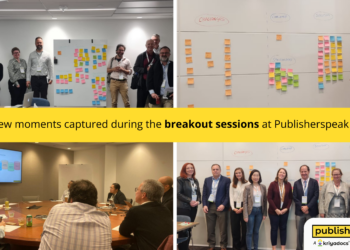
At the request of a professional society, I recently prepared some remarks on the context of scientific publishing. That session was not recorded, but I have taken the slides from it and am pasting them in below.
Now, you might ask, What the heck is the context of scientific publishing? I had in mind all the strategic issues that the head of a publishing organization has to keep in mind as he or she pilots the organization through the current environment. When I first began thinking about this, I had one issue (the regulatory environment and open access) in mind. But after making a presentation on that topic, I saw fit to add a second urgent strategic matter. Soon that led to a third, then a fourth. Now I am up to five, but I am not sure if I am still counting or not. What this underscores is that the current situation of society publishing is under a great deal of stress, with an army of strategic challenges besetting it on all sides. Think about this the next time somebody talks about the ivory tower.
What I would be interested to know is whether other observers of the practice of scholarly communications agree about the five items I have isolated; and the follow-on question is whether they would like to expand the list. That’s why blogs have Comments sections.
Discussion
21 Thoughts on "The Context of Scientific Publishing"
Joe, I might add one more item to your five: digitalization (not to be confused with digitization). By “digitalization” I mean the increasingly digital and computational nature of scholarly inquiry — a trend that we talk about more often in the humanities, where it seems more like a radical change, but which I think is also significant in the hard sciences and also provides a meaningfully new dimension of context for scientific publishing. It seems like more and more papers have computational components, and the need to keep and curate accompanying data is growing.
(By the way, I draw the distinction between “digitalization” and “digitization” because — in libraries anyway — we tend to use the latter term to mean “creating digital versions of analog objects.” By “digitalization” I mean scientific communication itself becoming increasingly bound up with computing. “Computationalization” might be a more accurate term, but as a word it’s even more horrifying than “digitalization.”)
The $5000 per article revenue number is pretty stark (also probably low). If the industry transitions to APC gold OA at $1300 per article then the industry has to shrink dramatically, to roughly a quarter of its present size, dollar-wise. Of course that is just what some OA advocates want, but I have trouble seeing the industry doing this voluntarily, much less strategically. It is also hard to see how a society could factor big numbers like this into their membership dues. What am I missing?
I think you’re missing the fact that a very large percentage of the APC money will come from research funders, meaning that what shrinks as a result is the amount of research being done, not the number of publishers.
I do not see how this is related to my point about revenue loss.
The other question you have to ask is, would an APC of $5,000 change the journal’s authorship? The talent pool would become smaller. Authors from developing nations would be discouraged, as would domestic authors with less generous funding. Your journal might survive, but would it be the same?
David and Ken (and I think Joe): There is a big difference between revenue and profit/contribution. There are costs associated with the $5,000 in revenue/article that are not needed when publishing a $1,300 gold OA article. I understand that there are expenses that will be incurred in publishing the OA article, both people and technology, but there is a lot of money being saved by not having to pay for printing, paper and postage. Maybe $1,300 is not enough to maintain the current levels of profit but I suspect the final number will be closer to $1,300 than $5,000.
Joe, to one of your larger points of what will be the proper role of scholarly societies in the new publishing paradigm, I think that one of the issues that societies have provided in the past and continue to do in the future is “discovery”. Previously we have solved the discovery problem by being the publishers. In an OA world there will be lots and lots of “free” content. People will still need someone to help them find what they are looking for and will probably be willing to pay for that service.
Overall, another excellent post.
David B: The point is that if you reduce the total revenue of the industry by 1300/5000 the loss is enormous, roughly 75%, and I do not think that print costs are consuming anything like 75% of present revenue. Moreover, and as I alluded to, Joe just divided the total industry revenue by the total number of articles published. But a significant fraction of those articles are published in free, subsidized journals, the revenue from which is probably not included in that numerator, so the present revenue per subscription article is probably significantly greater than $5000. This means to going to APC revenue of say $1300 is that much more of a loss.
I do not see how the industry can make this transition and survive in anything like its present form. Nor do I see any forces in play that are strong enough to force such a wrenching transition. So I simply do not see it happening.
I have long held the notion that society publishers in a similar subject area, like engineering, get together and form their own “big deal”. Together our aggregations can compete toe-to-toe with the commercials on pricing, and win on quality.
I agree completely. Such arrangements are hard to put together, but they represent a viable strategy in some disciplines.
The problem, Bruce, is that engineering is a lot of different subject areas (and disciplines), almost as broad as all of science. Many universities have a few strong engineering departments but few have many such departments. I also wonder about your apparent claim that societies consistently have higher quality journals than commercial publishers.
David, there is nothing “apparent” about my claim that society journals are generally of a higher quality than commercial journals. It is biased and based on anecdotal evidence, but I wager it is true nonetheless.
There are aggregators like BioOne (http://www.bioone.org) which creates something of a collections program for independent society publishers (and those on smaller platforms without a large collection). It certainly does bring in additional revenue, though in my experience, the reach is still lacking compared to that seen by larger publishers with international sales and marketing teams.
As Joe notes above, the arrangements can be tricky. As one example, how do you allocate income to each journal? By size? Prestige? Usage? Selling price?
David, let’s take a simple model. A society A is selling its journals to a library for $5000; society B $10,000; society C $15,000. Each society has set its price independently.
The library is paying $30,000 to three different publishers. Societies A, B, and C in unison quote the library $25,500, each reducing their prices 15%. As long as the library continues to purchase from the three societies, the 15% discount continues. If the library cancels one society, the other two will invoice the non-discounted price in the next renewal cycle.
As with the “big deal” we would be trading price for subscription continuity.
Bruce, there appears to be a misunderstanding about the origin of the $5,000 figure. That is not what a library pays. That is how much is received per article by the publisher across all sources of income: libraries, APC, advertising, royalties from aggregators, etc. The figure is as high as it is not because prices are high but because of the breadth of distribution by the publisher.
In your scenario, if I’m society C, why should I care if the library that is already buying my journal continues to buy your journals?
Similarly, if my journal has high usage, and a high impact factor, maybe I should get more of the overall revenue from the package deal than your journal which is of low quality and shows low levels of usage.
Joe, I’d be curious if you know the (approximate) distribution of societies across the 6 strategies you described in your presentation (from 1. go it alone to 6. create an arrangement with a behemoth). My guess would be that it’s biased toward 6, but would be interested to see the data. Thanks!
This is an interesting question, Tiffany, to which I do not know the answer. A quick response would be to say to go to the Web site of Wiley Blackwell and look at the evidence, but as large as Wiley’s portfolio is, it is still a fraction of the number of journals. To get at the answer, we would have to first define a journal (are there 25,000? 50,000?) and to break them into subject categories. It’s fair to say that STM is migrating toward category #6, humanities journals less so. But getting at the actual distribution would be an interesting research project.


